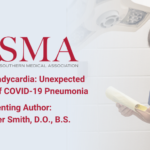Abstract | November 6, 2020
Blinded by Bradycardia: Unexpected Presentation of COVID-19 Pneumonia
Learning Objectives
- Bradycardia is a cardiac manifestation of COVID-19 that has not yet been widely published.
- It is imperative to maintain a broad differential with symptomatic bradycardia.
- Clinicians must be aware of this atypical cardiac presentation of COVID-19, especially in the setting of a pandemic.
Introduction: The first case of coronavirus disease 19 (COVID-19) was discovered in Wuhan, China in December 2019. Within a few short months, the Severe Acute Respiratory Syndrome-Coronavirus 2 (SARS-CoV-2) was declared a pandemic. The cardiac manifestations of COVID-19 were discovered relatively quickly, mostly in the form of direct myocardial injury, myocarditis and wide-complex arrhythmias. Acute cardiac injury (serum troponin elevation above 99th percentile) is the most commonly reported cardiac complication in COVID-19. Bradycardia is another cardiac manifestation of COVID-19 that appears to be relatively specific to the disease. Recent studies have correlated positive serum viral antigens to the extent of bradycardia and have observed resolution of bradycardia once viral serologies become negative. This can be an important diagnosis and prognosis tool in the setting of COVID-19.
Case Presentation: We present a 66-year-old Caucasian female with a past medical history of asthma, hypertension, and type-II diabetes mellitus. The patient complained of fevers, worsening shortness of breath and nonproductive cough for the past six days. The patient works as a nurse practitioner and admitted to recent exposure to patients with COVID-19. COVID-19 was confirmed by detection of SARS-CoV-2 in polymerase chain reaction (PCR) of nasopharyngeal specimen. Initial vitals revealed temperature 98.6°F, heart rate 50 bpm, respirations 16, BP 159/78, O2 sat 93% on Room Air. D- Dimer was elevated on admission 3,650; repeat negative x2. Initial labs reveal WBC normal, mild anemia, and mild hypokalemia. No overt acute kidney injury, but mildly elevated BUN of 24. Serum magnesium, troponin, and TSH were
also normal. Chest radiograph revealed signs of bilateral consolidations consistent with multifocal pneumonia. Chest CT Angiography was negative for pulmonary embolism, but did show consolidations consistent with COVID-19 infection.
EKG demonstrates sinus bradycardia of 46 bpm with no acute ST changes. Repeat EKG revealed significant bradycardia of 42 bpm, again without acute ST changes. On exam, patient was ill-appearing, alert, tachypneic, and in moderate respiratory distress with signs of accessory muscle use. Cardiac exam revealed obvious bradycardia without murmurs or rubs. The patient was symptomatic from her bradycardia, with dizziness and lower blood pressure observed with episodes of bradycardia. Differential diagnosis included COVID-19 related Sinus Node dysfunction, primary SA Node dysfunction, obstructive sleep apnea, medication adverse effect including AV-Blocking agents.
Final/Working Diagnosis:Bradycardia from Sinus Node Dysfunction, related to COVID-19
Management/ Outcome/and or Follow-up: Cardiology was consulted for evaluation of patient's bradycardia. After extensive review of the patient’s home and inpatient medications, medication adverse effect was essentially ruled-out. There was no correlation to the patient’s bradycardia to a specific activity or time of day. Transthoracic echocardiogram (TTE) was ordered to exclude structural heart pathology and revealed normal EF 54%, normal atrial and ventricular size, and no significant valvulopathy. Prophylactic Enoxaparin 80 mg SQ BID was provided since COVID-19 is known to significantly increase the risk of venous thrombosis. The patient’s bradycardia gradually improved with conservative management. Patient did not require temporary pacemaker placement. AV-Nodal blocking and QT prolonging agents were avoided throughout hospital stay. While the etiology could be multifactorial, severe hypoxia, damage of cardiac pacemaker cells from inflammatory cytokines, and exaggerated response to medications are possible triggers. The patient’s bradycardia ultimately resolved and the patient’s COVID-19 viral serology was repeated prior to discharge, which returned negative. This correlation may be an important tool in the diagnosis and management of COVID-19 patients.

